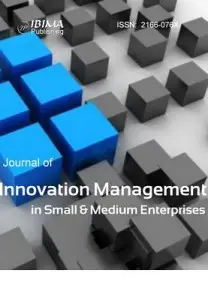Introduction
Customer service is one of the most important aspects of marketing for a product or a service. High quality customer service can help build customer loyalty and trust in new customers. It will also create customer chains when loyal customers themselves promote products or services to their peers (Shah et al., 2018; Shah et al., 2019). Customers today are not only interested in the products or services offered but also in all the additional elements of service they receive, from the moment they enter the market until the after-sales service. Customers will be satisfied if the service provided is fast, error-free, easy-to-find, non-burdensome and accompanied by a friendly and courteous service and a reasonable cost. Unidha (2017) reported that friendly relationships between customers and organizations are essential in providing input to improve the quality of the desired product or service. To ensure that an organization is able to maintain its competitive edge and lead the way, technology quality and survival factors are crucial to moving forward. The product or service provided will reflect the quality of an organization, the higher the quality of the product or service provided, the higher the trust level (Jung and Seock, 2017). Efficient and effective Customer Relationship Management will ensure the delivery of services that are responsive to customer needs and requirements. The standard of the service offered to the customer should be of high value up to his/her expectations in line with the delighting approach of the customer in technology. In addition to identifying their customers and their needs, organizations must also identify their target customers, whether internal or external. The Customer Relationship Management guide as well as understanding customers’ needs and requirements can be further enhanced with the fifth-generation technology. This is to ensure that the services offered can meet the customers’ needs. In this regard, customer feedback should be taken into account by organizations. Therefore, the core services of the organization need to be identified based on their roles and functions. They can also be determined based on the current focus area. The CRM can also be defined as the standard of service quality. In addition, Raji et al. (2017) observed that the identified customer requirements must be translated into a realistic service technology quality standard to ensure that the promise is fulfilled. The best possible service quality technology standards can be measured, for example, in terms of timeliness or number of outputs. In addition, qualitative features of customer service that cannot be measured, such as friendly, considerate, easy-to-understand, secure and so on, can also be standardized. A service recovery plan should be provided to ensure the implementation of the mechanism with the customers. Therefore, service recovery can be implemented efficiently and effectively in the event of failure to deliver the service as promised. In fact, the service recovery plan is a plan that contains carefully planned actions to restore service and maintain customers’ trust in the service provided.
Literature Review
The business world is closely linked to creativity and innovation. Without creativity and innovation, the business world will remain static without any changes and challenges. Thus, entrepreneurs who inculcate creativity and innovation in their business models will be more progressive and successful than others who adopt the traditional business model, being interested only in sales. Creativity and innovation refer to doing something out of the ordinary. Singh (2015) and Raji et al. (2017) highlighted that creativity and innovation can also be associated with, improvement and discovery. The concept of creativity and innovation is broad and can be applied in a variety of areas and circumstances, except for business. Customer management planning is crucial in strengthening the organization’s ability to understand customers’ needs and expectations so that the services offered can meet those needs. Technology strategy in terms of customer focus needs to be incorporated into the organization’s strategic plan in order to work effectively on customer relationship-based services. Organizational top management needs to define the customer service mission in a specific statement, and publicize it so that it becomes a commitment for all managers, owners and shareholders to carry out toward the organization’s customer service excellence. Hence, they can definitely target their customers, having their needs and expectations accurately defined and met. This is to ensure that the standard technology service offered meets customer satisfaction and is of high value up to the customer’s expectations (Shah et al., 2016; Shah et al., 2017). The provision of a customer service standard technology needs to be set and implemented to ensure the effectiveness and efficiency of the consistent service quality. This is in line with the efforts to enhance the excellence of the service delivery system. Suki (2014) and Soh et al. (2017) found that the service offerings, that are intended to be delivered to customers, must be provided through efficient working procedures and delivery processes to ensure providing a fast, easy and convenient service quality. Organizations in SMEs need to enhance customer service delivery through strengthening their organizational structure and providing facilities that enhance service offerings. Moreover, technology is a tool used to convey the delights necessary to keep up with current developments. Consequently, Abhishek et al. (2018) also found that careful planning needs to be done to identify the customer’s need for the service, which can be offered through the use of the latest tools and technologies that can meet the customer’s requirements. Organizations with high customer service transactions should explore the fifth-generation new technology in Customer Relationship Management. Therefore, they should aim at strengthening the internal operations that offer efficient services through a service-oriented structure (big data). Last but not least, premise management is of the same importance to improve service delivery efficiency and guarantee customer comfort, convenience and customer-friendly office layout including amenities for the less fortunate efforts, to allow customers to share their experiences.
Customer Relationship Management Performance
Customer relationship service is one of the most important aspects of marketing for a product or a service. High quality customer relationship services can help build customer loyalty and trust in new customers. Shah et al. (2018) and Wahab et al. (2017) identified that this also creates a customer chain when the loyal customers themselves promote the product or service to the surrounding consumers. Friendly relationships between customers and organizations are essential in providing input to improve the quality of the desired product or service. Customer service is often faced with a wide variety of customers out there. Therefore, it is important for each organization to ensure that it has good skills to always keep in touch with the customers. Moreover, good SMEs are the ones that know and want to impress their customers. It is important for the organization to provide the best services to its customers so that they are happy and comfortable. Moreover, Shah et al., (2016); Shah et al., (2017) defined one of the things SMEs can do, which is creating a lightweight organization. If employees often provide the best service for customers, it will indirectly make those customers feel valued. The needs of customers have to be met to make them feel appreciated. In addition to ensuring employees’ understanding in meeting the needs of existing customers, the relevant parties must always provide VIP services for their customers to make them happier. In addition, managers can also conduct surveys to come up with ideas and improvement plans if there are some areas that need improvement. No matter how productive a business is, feedback should be given to customers so that they are always updated (Zuraimi et al., 2013).
Technology Strategy
Customer relationship service is one of the most important aspects of marketing for a product or service. High quality customer service can help build customer loyalty and trust in new customers. It will also create a customer chain when the loyal customers themselves promote the product or service to another chain. Customers today are not only interested in the product or service offered, but also in all the added value of the service they receive, from the moment they enter the market until the after-sale service. Therefore, customers will be satisfied if the service provided is effective and efficient. Friendly relationships between customers and organizations are essential in providing input to improve the quality of the desired product or service. Information technology plays a vital role as a supporting tool to the organization (Norsyafiqah Filzah Mohamad Saodi et al., 2018). Lariviere et al. (2017) and Soh et al. (2017) stated that the tools and technologies used to deliver the services need to adapt to the current developments. Careful planning is important to identify customers’ needs so that services can be offered through the use of the latest tools and technologies that can meet those needs. Organizations that have high customer service transactions should constantly explore new technologies in Customer Relationship Management. This is aimed at strengthening their internal operations and offering efficient services through the appropriate technology-based service-oriented structure. Moreover, Paddeu at al. (2017) and Shah et al. (2017), in another study, reported that technology is integral to the magic behind our ability to provide quality products and review-worthy experiences. Some may argue that technology can be a barrier to great customer service, however, behind the scenes, technology is driving efficiencies in SMEs’ operations which assist communications, provide ongoing training, manage quality assurance and more. For SMEs, the right balance of technology and implementation can help improve operations, as well as quantify and create a cohesive brand experience, no matter which location a customer visits. In their study, Thammawimutti et al. (2018) and Shah et al (2019) examined that with technology, the logistic provider can quantify the customer experience and provide data on what might be missing. Technology helps to ensure that logistic operations are running smoothly and that SMEs can communicate with a customer through a centralized platform regarding questions or actions. Flawless execution can be tough to manage for a logistic that may not be located physically near every single logistic location, and a centralized management platform helps to bridge any communication gaps and set SMEs up for success. In another study, Zhou et al. (2019) and Miroslava (2013) reported that to ensure all locations are providing the best brand-consistent experience possible, the logistic provider should consider an effective field team or solution. If a technology solution is utilized, it should be mobile-centric and should include brand-specific surveys with visual documentation capabilities, corporate and franchise feedback and critical action notification as well as automated corrective action plans with the required follow-up procedures. The most effective review tools will compile historical and trending reports to identify locations heading too strongly off the path of success. Similar to managing logistic provider operations, technology can also be used to capture, qualify and convert SMEs’ leads into sales. Technology can help grow a business by reaching new customers through text messaging, digital signage and social media campaigns (Jamaluddin and Ruswanti, 2017; Shah et al., 2018)
Customer relationship management performance and technology strategy
Managing customer experience can also be referred to as assessing a customer’s understanding or perception of a product or service that has been offered or that will be offered to customers in the future. Moreover, customers’ knowledge in evaluating or looking at a product can provide an opportunity to improve transportation services in the future. Customer Relationship Management is introduced to enhance organizational and customer relationships and thus meet the increasing demands and expectations of customers. However, Paddeu et al. (2017) point out that Customer Relationship Management is a holistic approach to service delivery through the effective management of interactions and relationships between organizations and customers. This approach focuses on delivering a technology service that is based on customer needs where customers are treated as individuals rather than as a component of the service delivery process. Other authors, such as Liu and Wang (2017), mentioned that customer engagement is also taken into account in designing the services so that the services offered can meet the customers’ needs and satisfy them. Furthermore, Customer Relationship Management (CRM) is a holistic approach to provide services that meet customers’ needs and expectations through managing effective interactions and relationships between organizations and customers. Organizations need to identify their target customers so that their needs and expectations can be better defined and met. This is to ensure that the standard of the technology service offered is of high value that exceeds the customers’ expectations. Perfection in terms of facilities, technology, logistics and other relevant products is essential to enable the organization to implement its customer service mission (Shah et al., 2016; Shah et al., 2017). Customer service is the ability of the organization to improve the delivery of products to the customer, and it is the responsibility of all the units in that organization. Leaders and managers can determine the organization’s pattern and direction. In order to succeed in the mission of customer service, organizational leaders must understand and practice customer-value-oriented leadership and administration (Shah et al., 2018; Shah et al., 2019).
Objectives of the study
The objectives of this study is as follow:
- To investigate the impact of technology strategy on customer relationship management performance of SMEs’ logistic provider.
Methodology
This research is an empirical test as well as a correlational research in nature. According to Hair et al. (2010), the number of respondents in the pilot test should be more than thirty as well as appropriate and acceptable for analyses which are greater than 100 samples as suggested by (Hair et al., 2010; Sekaran and Bougie, 2013). A questionnaire survey was carried out for this research and distributed to the respondents that are the customers of the logistic service provider. A Likert scale questionnaire was also applied in this study. The research population is the target groups which are the individuals or the customers of the logistic service provider. The target population of this study was three hundred and ninety-one respondents from Johor Bharu, Selangor and Pulau Pinang in X, Y, and Z organizations.
Theoretical Background for the Models
Logistic service business is considered as a way of expanding the business faster and cheaper. This is because the logistic business is all managed by a systematic automation. It will affect the customer’s benefit. Logistic service business allows the transfer of technology and expertise between companies and local customers (Paddeu et al., 2017). This can be realized when a logistic service provider appoints a local company as the technology strategy for a particular area. In this regard, Chen and Popovich (2003) proposed the perfect underneath to present and support the impression of numerous authors on the significance of technology strategy in realizing Customer Relationship Management Performance in the organization.
Theoretical Framework
For this study, the present research proposed a technology strategy as the determination of Customer Relationship Management Performance models for SMEs in Malaysia. The complete models proposed are as follows.
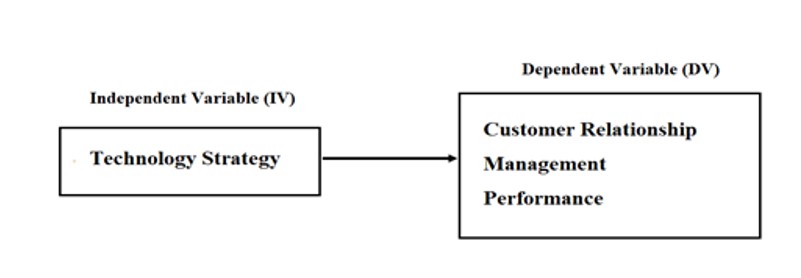
Fig 2. Theoretical Framework
Hypotheses Development
Paddeu et al. (2017), Soh et al. (2017); Shah et al. (2019); Shah, et al. (2018); Shah et al. (2017) and Shah et al. (2016), at past research, investigated the character of the value provider in technology strategy and found that there is a positive significant relationship between technology strategy and customer relationship management performance. Therefore, it is hypothesized that:
Hypothesis
There is a significant relationship between the technology strategy factor and Customer Relationship Management Performance.
Result
The SEM model and relevant data are shown in Table 1, Table 2 and Figure 3. The model fit parameters were similar to previous SEM analyses. These were considered minimally acceptable for the exploratory research which focused on scale development (Hair et al., 2010.; Anderson and Gerbing, 1988). The data was analyzed using SEM analysis, which is previously tested for validity and reliability. Results of the examination of goodness are fit for the overall model and were in accordance with the result of the SEM analysis, in order to determine whether the hypothetical model is supported by empirical data. This section gifts the particulars of data analysis to assess the measurement model and structural model concurrently by using SEM analysis. Moreover, measurement instruments are evaluated via the CFA dimensionality, reliability and validity of model, where the indicators are measured by multiple items (Crockett, 2012). Figure 3 presents the extended analysis of the SEM independent variable model. Numerous knowledgeable specialists analyzed these results and decided that they were rational, mainly because table regression weight and standard regression weight, in this same research, confirmed that the relationship is positive and significant. One clarification for the illogical finding of the relationship between technology strategy and customer relationship management performance was the option of a suppressor effect due to interactive effects of multicollinearity in the SEM analysis. Thus, the partial model independent variable is demonstrated and Hypothesis H4 is accepted. Nunnaly (1978) suggests that all of the variables in the model were estimated to fulfill the criteria of the discriminant validity. Then, it can be concluded that all of the variables have a good reliability. Below is the analysis for regression weight and the standard regression weight.
Table 1: Regression Weights
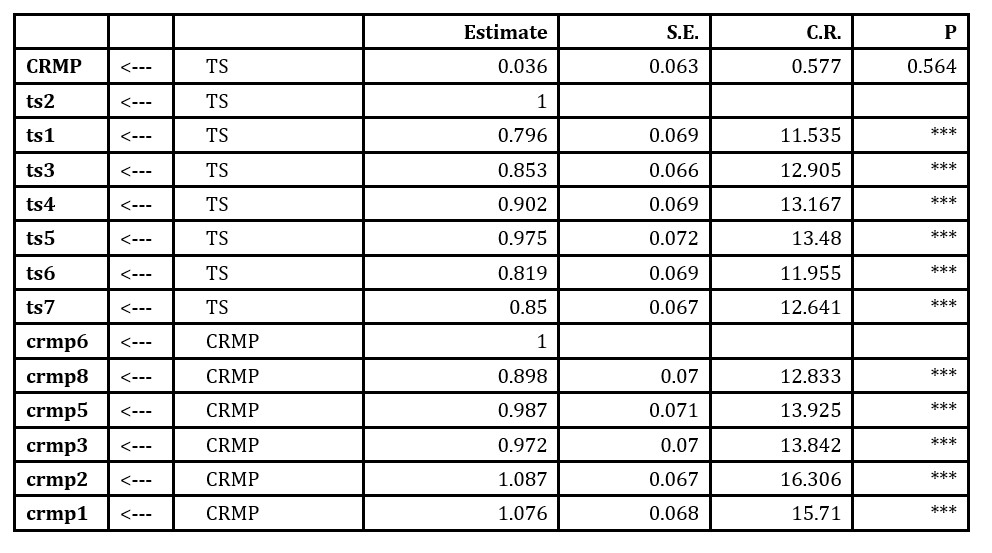
Table 1: Regression Weights
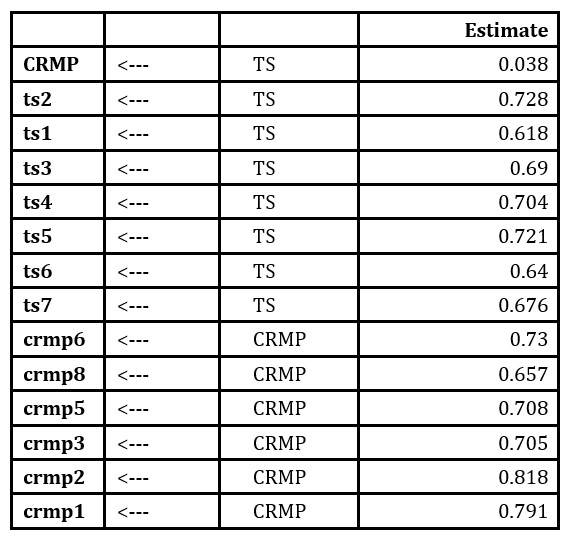
The above mentioned results are providing an added predictive validation for the relationship between technology strategy and customer relationship management performance. As discussed in the theoretical framework, technology strategy is viewed as integral to firm performance (FP). Thus, technology strategy is likely to impact firm performance positively. A model, representing the relationship between technology strategy and firm performance using SEM-based path analysis, was tested next.
Research Findings
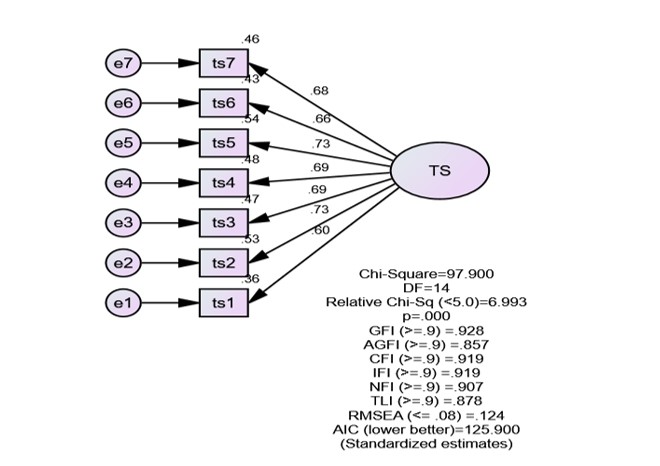
Fig 3. SEM Technology Strategy
According to Figure 3, the outcomes presented that the technology strategy is a leading feature of improving performance. The result of the analysis of variables showed that the measurement model, if the variables and all numbers and parameters of the model are proper, is meaningful. Measurements that are the highest in reflecting the customer relationship management are the reward, followed by technology strategy and customer relationship management performance. The SEM path analysis resulted in a chi-square of 97.900, DF of 14. The relative chi-square was 6.993. Furthermore, the Good fit Index was .928. Moreover, AGFI was .857. The comparative fit index was .919 and the IFI was .919. NFI was .907. TLI was .878, RMSEA was .124, with 80 percent confidence level, and last but not least, AIC was 125.
The outcomes of this study exemplify that the improved technology strategy of customer relationship management performance industries has the most significant relationship by the capability of the management to deliver a product and service to customers. The application of customer priority also played a role in increasing the customer relationship marketing.
Discussion
In conclusion, customer relationships need to be managed as a whole and integrated as a step towards meeting customers’ needs and requirements. This Customer Relationship Management guide details the quality of customer service and the steps that need to be taken under the dome of customer relationship management to help organizations improve their customer relationship management. This study emphasizes that customer engagement, as a receiving service, is a key factor in shaping the organization’s form, method and level of service delivery. In addition, customer service performance management is an important component of ensuring that the best services are delivered to customers consistently and in line with the customer’s transform approach. An organization with a high quality customer service depends on satisfied customers, and thus, provides support for the organization. It is not solely the responsibility of one section to attract customers, as all other sections of the organization are also responsible for providing a quality customer service. In addition, customers’ perceptions of the organizational productivity and services need to be constantly reviewed so that feedback on the organizational performance can be obtained to enable institutions to find ways to improve their performance. The services or products provided should be as much as possible based on customer demand and requirements and not solely on the management. In essence, no organization can achieve success without building good relationships with customers. Increasing customer satisfaction by understanding customers’ requirements is one way to gain customer loyalty and customer retention.
Conclusion
Due to the globally technological changes, with economic and business conditions such as technological advances, it is essential to implement an information system throughout organizations (Asyraf Mohd Bakri et al., 2017). The need to modify the information system or change the management’s requirements may be necessary. Technology plays an important role in Technopreneurship. It is an essential tool for enhancing the organizational performance . With the evolution of data communication networks through computer systems, this system connects a large structure that can exchange information even if it is located in the opposite hemisphere. Organizations need to set standards, processes, procedures, directives and a work culture that ensure excellent customer service in order to achieve and maintain a high level of product delivery. Regardless of the processes, procedures, facilities and resources provided, if the attitude and commitment of the employee are not customer-driven, the organization will not reach the required level of customer service quality. Furthermore, organizations need to adopt an effective monitoring system for every activity in the preparation and delivery of products to customers (Brdiger & Wood, 2017; Shah et al., 2018). Through monitoring internal processes and activities and external interactions with customers, the organization will always be prepared to correct any shortcomings and errors. Last but not least, innovation is the specific tool of entrepreneurs, the means by which they exploit change as an opportunity for a different business or a different service.
Acknowledgment
This paper is funded by DUCS Grant, IRMI Universiti Teknologi MARA Cawangan Selangor. Reference no: UITMSEL (P1. 5/4) (005/2018).
(adsbygoogle = window.adsbygoogle || []).push({});
References
- Asyraf Mohd Bakri, Nur Hamezah Abdul Malik and Norhayati Hussin (2017), ‘The Competency of Information System Management in an Organization for Better Decision-Making,’ International Journal of Academic Research in Business and Social Sciences, 7 (12). ISSN: 2222-6990.
- Anderson, J.C. and Gerbing, D.W. (1988), ‘Structural equation modeling in practice: a review and recommend two-step approach,’ Psychological Bulletin, 103 (3), 411-423.
- Abhishek D, Johnson L.W and Charles W. D. (2018), ‘Consumer emotional brand attachment with social media brands and social media brand equity,’ European Journal of Marketing, 43 (3), 276–292.
- Brdiger E.K. and Wood A. (2017), ‘Gratitude mediates consumer responses to marketing communications,’ European Journal of Marketing, 51(1), 44–64.
- Crockett, S. (2012) ‘A five-step guide to conducting SEM analysis in counselling research,’ Counselling Outcome Research and Evaluation, 3(1), 30-47.
- Chen, I. J., and Popovich, K. (2003), ‘Understanding customer relationship management (CRM),’ Business Process Management Journal, 9 (5), 672-688.
- Singh, H. S. (2015) ‘The Effect of Satisfaction on Customer Loyalty in Logistics Outsourcing Relationships’. ASM’s International E-Journal on Ongoing Research in Management and IT E-ISSN-2320-0065, 228-241.
- Hair, J., Black, W., Babin, B., Anderson, R., and Tatham, R. (2010). ‘SEM: An introduction. Multivariate data analysis,’ A global perspective, 629-686.
- Hair, J.F., Black, W.C., Babin, B.J., and Anderson, R.E. (2010) Multivariate Data Analysis, A Global Perspective, 7th ed. New Jersey, Pearson Education Inc.
- Jung N.Y. and Seock Y.K. (2017), ‘Effect of service recovery on customers’ perceived justice, satisfaction, and word-of-mouth intentions on online shopping websites,’ Journal of Retailing and Consumer Services, 37(C): 23–30.
- Jamaluddin, Endang and Ruswanti, E., (2017), ‘Impact of Service Quality and Customer Satisfaction on Customer Loyalty: A Case Study in a Private Hospital in Indonesia’. [Online] IOSR Journal of Business and Management (IOSR-JBM). eISSN: 2278-487X, p-ISSN: 2319-7668. Volume 19, Issue 5. Ver. I (May. 2017), 23-33. Available: www.iosrjournals.org.
- Larivière, B., Bowen, D., Andreassen, T. W., Kunz, W., Sirianni, N. J., Voss, C., Wünderlich, N. V. & De Keyser, A. (2017), “Service Encounter 2.0”: An investigation into the roles of technology, employees and customers. Journal of Business Research, 79, 238-246.
- Liu, C., & Wang, T. Y. (2017). A study on the effect of service quality on customer loyalty and corporate performance in financial industry.’ Problems and perspectives in Management, 15,(2) (cont. 2), 355-363.
- Muhamad Fairos Mohamad Shah (2019) ‘Exploring Characteristic Of Customer Relationship Management Performance In Business Satisfaction Provider’. [Online] Proceding Palm Oil: Economic Colloquium 2019. Available: https://Mpob.Gov.My.
- Muhamad Fairos Mohamad Shah (2019), ‘Hubungan Di Antara Kesetiaan Perhubungan Pelanggan Terhadap Teknologi Penghantaran Perkhidmatan Kecilsederhana,’ [Online] Proceding Seminar Penyelidikan Kebangsaan Penyelidikan Pemangkin Kecemerlangan Pendidikan. F25 143-150. E-ISBN: 978-983-2084-48-8. Available: https://Seminarfpe.Wixsite.Com/Spk2019.
- Muhamad Fairos Bin Mohamad Shah and Samsudin Bin Wahab (2019), ‘Customer Relationship Management Association on Financial Strategy Logistic Service’. [Online] Proceeding International Conference on Design Industries And Creative Culture. (P16). p2 Available: https://Designdecodeduitm.Wixsite.Com/Designdecoded2018.
- Muhamad Fairos Mohamad Shah and Samsudin Wahab (2019), ‘Association Development Education of Technology Strategy Performance On Customer Characteristic,’ [Online] Proceeding International Conference On Education And Teacher Development (ICETD2019). Hc13, p14. Available: https://Icetd.Educonferences.Net/19/.
- Muhamad Fairos Mohamad Shah, Samsudin Wahab, and Mohd Amirrul Mohd Rosli, (2018). ‘Determination Competitive of Customer Relationship Management and Administration in Education,’ [Online] Proceding of 5th International Education Postgraduate Seminar (5th IEPS 2018), pp19 ID 5. Availeble: https://educ.utm.my/ieps2018/.
- Muhamad Fairos Mohamad Shah, Samsudin Wahab, and Anas Tajudin (2018) ‘The Contributing Future Trends in Education of Financial Strategy on Customer Relationship Management Performance Characteristic: A Pilot Study among SME’s Logistic Operators,’ [Online] Proceedings of the International Conference on the Future of Education 183(D20)114, ISSN 1985-1731. Available: http://www.iconfed 2018.my.
- Muhamad Fairos bin Mohamad Shah, and Samsudin b Wahab,Mohd Subri b Tahir (2017) ‘The Contributing Factor of Technology Strategy on Customer Relationship Management Performance: A Pilot Study among SME’s Logistic Operators,’ [Online] The 4th World Conference on Islamic Thought and Civilization,147-154, Journal of Thaqafah. Available: http://www.wcit.my.
- Muhamad Fairos bin Mohamad Shah, and Samsudin b Wahab, Norhayati bt Hussin (2017). ‘The contributing Factors of Business Process Strategy on Customer Relationship Management Performance: A Pilot Study among SME’s logistic operator,’ [Online] 3rd International Conference on Information Science,006;22. The Journal of Services Marketing. Available: http://www.ipneducationgroup.org/.
- Muhamad Fairos bin Mohamad Shah, and Samsudin bin Wahab (2017), ‘The Contributing Factors of Location Strategy on Customer Relationship Management Performance: A Pilot Study among SME’s Logistic Operators,’ [Online] National Conference on Creativity in Education and Humanities. OP54, Journal of Economics, Business and Management. Available: http://www.ncc2017.usm.my/.
- Muhamad Fairos bin Mohamad Shah, and Samsudin b Wahab. (2017), ‘The Mediating Effect Of Customer Intention Toward Customer Relationship Management Performance Among Malaysia Logistic Service Industries,’ [Online] International Conference Islam Borneo (X), (Ekp 007), International Journal of Entrepreneurial Behaviour & Research. Available: //www.kaib.com.my/
- Muhamad Fairos b Mohamad Shah, Samsudin b Wahab, and Mohd Subri b Tahir (2016), ‘The determinant of Supplier 2 Customer Relationship Management Performance Model for SMEs’. [Online] International Conference on Post Graduate Education (ICPE-7); T02,47, (36) 1284-1293. Journal of Information, Knowledge and Management. Available: http:// www.ipsis.uitm.edu.my/icpe7//.
- Muhamad Fairos b. Mohamad Shah, Samsudin b. Wahab and Mohd Subri b. Tahir (2016, ‘Customer-Supplier Relationship Management Performance Model for SMEs: The Integration of Financial and Technology Strategy’. [Online] Advances in Business Research International Journal, 2 (2), 567. Available: www.abric2016.uitm.edu.my/
- Muhamad Fairos bin Mohamad Shah, Samsudin b Wahab and Mohd Subri b Tahir (2016), ‘Customer-Supplier Relationship Management Performance Model for SMEs: Missing Link between Logistic and Business Intermediaries,’ [Online] ASEAN Entrepreneurship Journal AEJ, 2(2),16-26, (ISSN 2289-2125) Available: http://aej.uitm.edu.my/
- Miroslava Rakovska (2013), ‘The Impact of Strategy and Logistics on Performance: A Methodological Framework. Research in Logistic and Production.’ Journal of Relationship Marketing, 3 (3), 213-223.
- Norsyafiqah Filzah Mohamad Saodi, Muhammad Sharis Ikhwan Idris, Noradilah Aiza Saharuddin, Saiful Farik, Mat Yatin, Norhayati Hussin, Azmi Ab Rahman (2018), ‘The Emerging Roles of Information Management in Government Agencies’. International Journal of Engineering & Technology, 7 (3.7) (2018) 245-248.
- Nunnaly, J.C. (1978). Psychometric theory (2nd ed.). New York: McGraw-Hill.
- Paddeu D, Fancello G, and Fadda P (2017) ‘An experimental Customer Satisfaction Index to evaluate the performance of city logistics services,’ Transport, 32(3):262–271.
- Rizwan, Qayyum, Qadeer, and Javed, (2014) ‘The impact on branded product on consumer purchase intentions’. [Online] Journal of Public Administration and Governance, 4, (3)57-74. Doi: 10.5296/ jpag.v4i3.5849 Available: http://dx.doi.org/10.5296/ jpag.v4i3.5849.
- Sekaran, U. and Bougie, R. (2013) ‘Research Methods for Business: A Skill-Building Approach’. 6th Edition, Wiley, New York.
- Thammawimutti, A., and Chaipoopirutana, P. D. S. (2018), ‘The relationship between brand equity,product attributes and purchase intention: A study of Sony digital cameras in Bangkok’. AU Journal of Management, 3(1), 5-10.
- Raji M.N.A, Zainal A (2017), ‘The effect of customer perceived value on customer satisfaction: a case study of Malay upscale restaurants’. Geografia-Malaysia Journal Society and Space, 12(3):593–598
- Suki, N.M. (2014), ‘Passenger satisfaction with airline service quality in Malaysia: A structural equation modeling approach,’ Research in Transportation Business & Management, 10, 26-32.
- Samsudin Wahab, Sofea Adriana A Jamalulil, and Muhamad Fairos bin Mohamad Shah (2017), ‘The Relationship between Service, Process, Organization and Marketing Innovations towards Firm Performance: Views of Broadcasting Industry in Malaysia’ .[Online] (AEMS 2017) International Conference on Advanced Education and Management Science, 2335, 125-129. Available: http://www.aems2017.org//.
- Soh K.L., Chin S.H. and Wong W.P. (2017), ‘A theoretical model to investigate customer loyalty on logistics service providers for sustainable business performance,’ International Journal Business Perform Supply Chain Model, 7(3):212–223
- Unidha, M. (2017), ‘The Effect of Service Quality on Trust and Loyalty for Giant Customers in Malang City,’ Arabian Journal of Business and Management Review, 7 (5), 1-5.
- Zhao, X., Zhang, W., and He, W. (2019), ‘Research on customer purchase behaviors in online take-out platforms based on semantic fuzziness and deep web crawler,’ Journal of Ambient Intelligence Human Computer, 1 – 5, doi:10.1007/s12652-019-01533-6.
- Zuraimi, A.A., Yaacob, M.R. and Ibrahim, M.D., (2013), ‘Logistics development in Malaysia East coast region: Infrastructure, constraints and challenges’. International Journal of Trade, Economics and Finance, 4(5), p.325.



